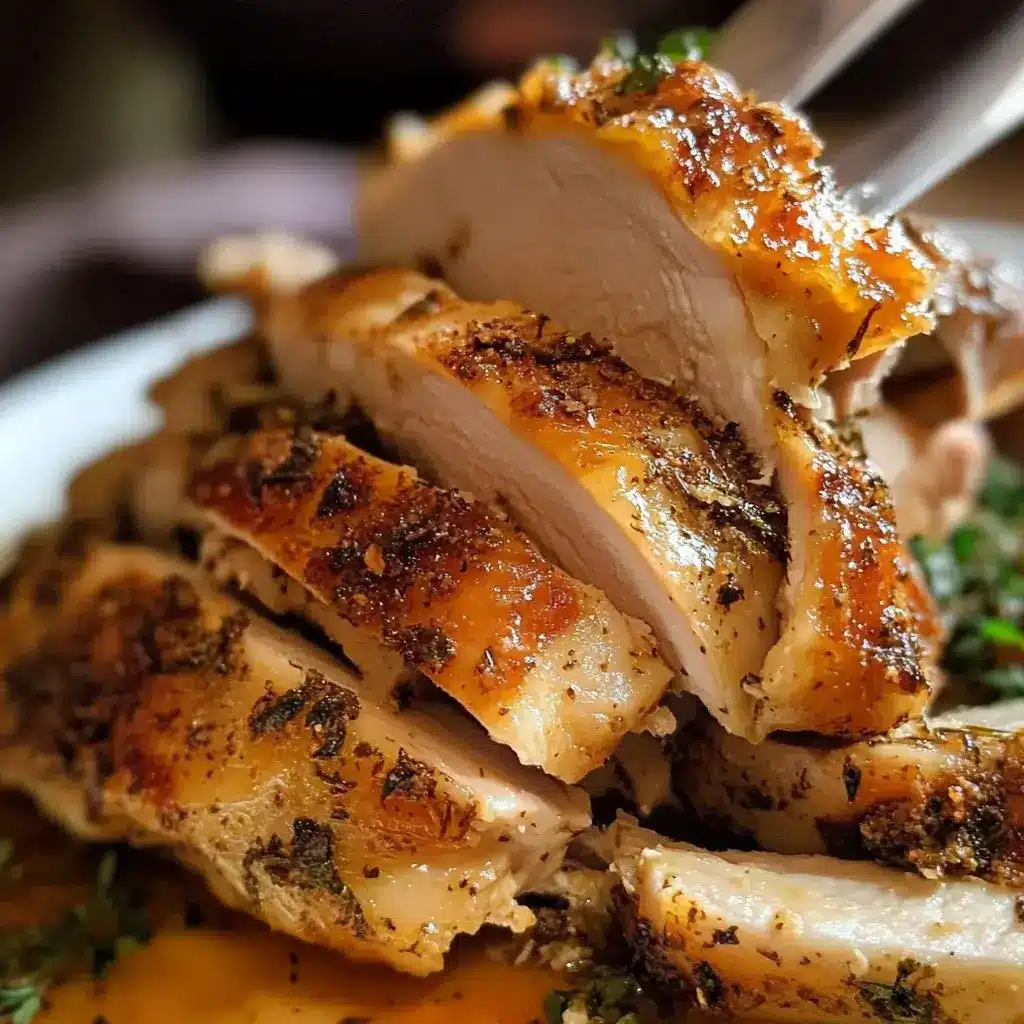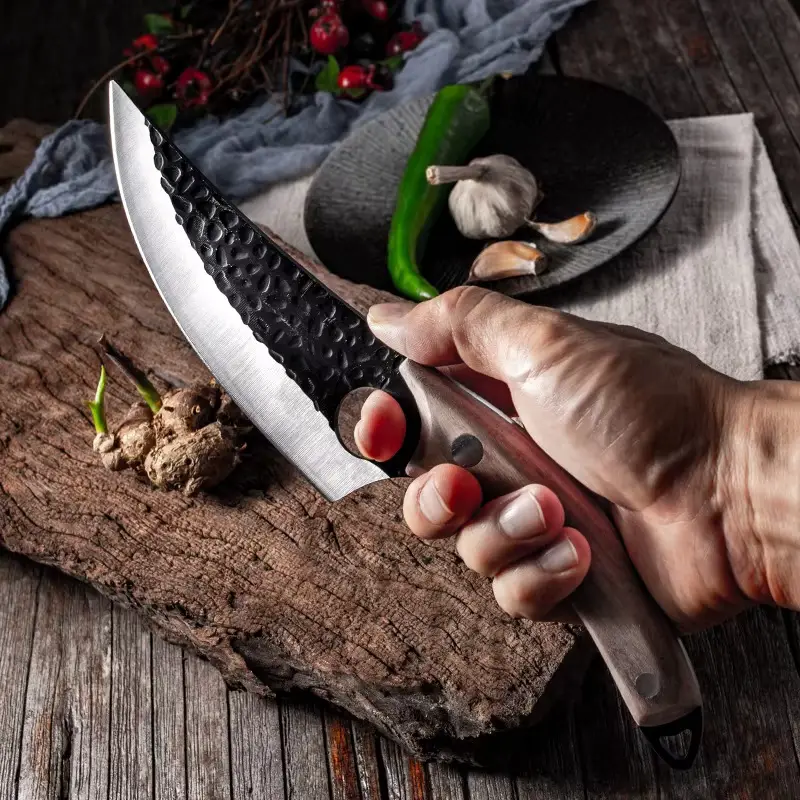In our home, weeknight dinners often need to strike a delicate balance: they must be relatively easy to prepare, satisfyingly delicious, and something the whole family will actually enjoy. Let’s be honest, sometimes that feels like an impossible trifecta! But recently, I stumbled upon a recipe that has become our new go-to for achieving just that – the Herb-Crusted Chicken Roast. From the moment the aroma of roasting herbs and chicken filled the kitchen, I knew we were onto something special. The chicken emerged from the oven with a beautifully crisp, golden-brown crust, fragrant with rosemary, thyme, and garlic. And the taste? Absolutely divine! The meat was incredibly juicy and flavorful, infused with the herbaceous notes from the crust. Even my pickiest eater devoured it, declaring it “the best chicken ever!” This Herb-Crusted Chicken Roast is not just a meal; it’s an experience, a comforting and delicious centerpiece that’s perfect for any occasion, from a casual family dinner to a more special gathering. It’s simple enough for a weeknight, yet elegant enough to impress guests. Trust me, once you try this recipe, it will become a cherished staple in your own kitchen too.
Ingredients for Herb-Crusted Chicken Roast
Here are the simple, fresh ingredients you’ll need to create this incredibly flavorful Herb-Crusted Chicken Roast:
- Whole Chicken (about 4-5 lbs): The star of the show! Choose a good quality, fresh whole chicken. A whole chicken provides a beautiful presentation and is perfect for roasting, ensuring juicy meat and crispy skin.
- Fresh Rosemary (2 tablespoons, chopped): Rosemary brings a pungent, piney aroma and flavor that is classic with roasted chicken. Its robust nature stands up well to the heat of the oven.
- Fresh Thyme (2 tablespoons, chopped): Thyme offers a slightly earthy, lemony flavor that complements the rosemary and chicken beautifully. It adds depth and complexity to the herb crust.
- Fresh Parsley (1/4 cup, chopped): Parsley provides a fresh, clean, and slightly peppery note, brightening the overall flavor profile and adding a touch of vibrancy to the herb crust.
- Garlic Cloves (4-5 cloves, minced): Garlic is essential for savory flavor. Minced garlic infuses the herb crust with its pungent and aromatic qualities, creating a wonderful base note.
- Lemon (1, zested and juiced): Lemon zest adds a bright, citrusy aroma and flavor to the herb crust, while lemon juice tenderizes the chicken and adds a touch of acidity for balance.
- Olive Oil (1/4 cup): Olive oil helps bind the herb mixture together, creates a beautiful crispy crust, and adds richness to the flavor. Use a good quality extra virgin olive oil for the best taste.
- Salt (2 teaspoons): Salt is crucial for seasoning the chicken and enhancing all the other flavors. Use kosher salt or sea salt for best results.
- Black Pepper (1 teaspoon, freshly ground): Freshly ground black pepper adds a pungent and slightly spicy kick, complementing the herbs and garlic and enhancing the overall savory flavor.
Instructions: How to Make Herb-Crusted Chicken Roast
Follow these simple step-by-step instructions to create your own delicious Herb-Crusted Chicken Roast:
Step 1: Prepare the Chicken
Begin by preheating your oven to 400°F (200°C). While the oven is preheating, prepare your chicken. Remove the chicken from its packaging and take out any giblets or neck that might be inside the cavity. Rinse the chicken thoroughly under cold running water, both inside and out. Pat the chicken completely dry with paper towels. This step is crucial as dry skin is key to achieving crispy skin during roasting. Place the chicken in a roasting pan. A roasting pan with a rack is ideal as it allows air to circulate around the chicken, promoting even cooking and crisping. If you don’t have a rack, you can use cut vegetables like carrots, celery, and onions as a makeshift rack to lift the chicken slightly off the bottom of the pan.
Step 2: Make the Herb Crust
In a medium-sized bowl, combine the chopped fresh rosemary, chopped fresh thyme, chopped fresh parsley, minced garlic cloves, lemon zest, olive oil, salt, and freshly ground black pepper. Mix all these ingredients together thoroughly until they are well combined and form a fragrant herb mixture. The olive oil will help bind the herbs and garlic together, creating a paste-like consistency that will easily adhere to the chicken.
Step 3: Apply the Herb Crust to the Chicken
Using your hands, generously rub the herb mixture all over the outside of the chicken. Make sure to coat every part of the chicken, including the legs, thighs, breast, and wings. For even more flavor, gently loosen the skin of the chicken breast by sliding your fingers underneath it, starting from the neck cavity. Be careful not to tear the skin. Once you’ve loosened the skin, carefully spread some of the herb mixture underneath the skin, directly onto the chicken breast meat. This will infuse the breast meat with flavor and keep it moist during roasting. Finally, squeeze the juice of half a lemon over the entire chicken. For extra flavor and aroma, you can also place the squeezed lemon halves and a few sprigs of fresh rosemary and thyme inside the chicken cavity.
Step 4: Roast the Chicken
Place the roasting pan with the herb-crusted chicken in the preheated oven. Roast for approximately 1 hour and 15 minutes to 1 hour and 45 minutes, or until the chicken is cooked through and the juices run clear when you pierce the thickest part of the thigh with a meat thermometer. The internal temperature of the chicken thigh should reach 165°F (74°C) for safe consumption. The exact roasting time will depend on the size of your chicken and your oven. It’s always best to use a meat thermometer to ensure accurate doneness.
Step 5: Basting for Extra Flavor and Moisture (Optional)
For even more flavorful and moist chicken, you can baste the chicken with its pan drippings during roasting. About halfway through the cooking time, around 45 minutes into roasting, carefully remove the roasting pan from the oven. Using a spoon or a baster, spoon the pan drippings over the chicken. This will help to keep the chicken moist and add extra flavor to the skin. Return the roasting pan to the oven and continue roasting until the chicken is done.
Step 6: Let the Chicken Rest
Once the chicken is cooked through and reaches an internal temperature of 165°F (74°C), remove the roasting pan from the oven. Transfer the chicken to a cutting board and tent it loosely with aluminum foil. Let the chicken rest for at least 10-15 minutes before carving. Resting is crucial as it allows the juices to redistribute throughout the meat, resulting in a more tender and juicy chicken. While the chicken is resting, you can use the pan drippings to make a delicious pan gravy, if desired.
Step 7: Carve and Serve
After the chicken has rested, it’s time to carve and serve. Carve the chicken according to your preference, separating the legs, thighs, wings, and breast meat. Arrange the carved chicken on a serving platter, garnish with fresh herbs if desired, and serve immediately. Enjoy your flavorful and perfectly roasted Herb-Crusted Chicken Roast!
Nutrition Facts for Herb-Crusted Chicken Roast
(Per serving, approximate values, based on 6 servings from a 4.5 lb chicken. Nutritional values can vary based on chicken size, specific ingredients, and serving sizes.)
- Serving Size: 1/6 of the roasted chicken
- Calories: 450 kcal
- Protein: 50g
(Note: These are estimated values and should be used as a general guide. For precise nutritional information, use a nutrition calculator with the exact brands and quantities of ingredients used.)
Preparation Time for Herb-Crusted Chicken Roast
This Herb-Crusted Chicken Roast is surprisingly simple to prepare, making it perfect for both weeknight dinners and weekend gatherings. The active preparation time, which includes chopping the herbs, mincing the garlic, zesting the lemon, and applying the herb crust to the chicken, is approximately 20-25 minutes. The total cooking time in the oven is around 1 hour and 15 minutes to 1 hour and 45 minutes, depending on the size of the chicken. Factor in an additional 10-15 minutes for resting the chicken before carving. Therefore, from start to finish, you can expect this delicious Herb-Crusted Chicken Roast to be ready in about 1 hour and 45 minutes to 2 hours and 25 minutes. Most of this time is hands-off oven roasting time, allowing you to prepare side dishes or relax while the wonderful aromas fill your kitchen.
How to Serve Herb-Crusted Chicken Roast
This versatile Herb-Crusted Chicken Roast pairs beautifully with a wide variety of side dishes and can be served for various occasions. Here are some serving suggestions:
- Classic Side Dishes:
- Roasted Vegetables: Roast vegetables like potatoes, carrots, broccoli, Brussels sprouts, or sweet potatoes alongside the chicken in the oven for a complete and easy meal. Toss them with olive oil, salt, pepper, and perhaps a sprinkle of the herb mixture for extra flavor.
- Mashed Potatoes: Creamy mashed potatoes are a comforting and classic accompaniment to roasted chicken.
- Green Salad: A fresh green salad with a light vinaigrette provides a refreshing contrast to the richness of the chicken.
- Steamed Green Beans or Asparagus: Simple steamed green vegetables offer a healthy and vibrant side dish.
- Rice Pilaf or Quinoa: Fluffy rice pilaf or quinoa provides a satisfying grain side dish that soaks up the delicious pan drippings.
- Occasions:
- Family Dinner: Perfect for a comforting and satisfying weeknight or weekend family dinner.
- Holiday Meal: An elegant and flavorful centerpiece for Thanksgiving, Christmas, Easter, or other holiday gatherings.
- Sunday Roast: A classic Sunday roast option that’s both impressive and relatively easy to make.
- Special Occasions: Impress guests at dinner parties or celebrations with this flavorful and beautifully presented chicken roast.
- Garnishes:
- Fresh Herbs: Garnish the serving platter with extra sprigs of fresh rosemary, thyme, and parsley for visual appeal and added aroma.
- Lemon Wedges: Serve with lemon wedges for guests to squeeze extra lemon juice over their chicken if desired.
- Pan Gravy: Make a simple pan gravy from the pan drippings for an extra layer of flavor and richness.
Additional Tips for the Best Herb-Crusted Chicken Roast
Here are some helpful tips to ensure your Herb-Crusted Chicken Roast is a resounding success every time:
- Use Fresh Herbs for Maximum Flavor: Fresh herbs are key to achieving the vibrant and aromatic flavor of this recipe. Dried herbs can be used in a pinch, but fresh herbs will provide a much more pronounced and delicious flavor. If using dried herbs, generally use about 1/3 of the amount called for fresh herbs.
- Don’t Skip Drying the Chicken: Patting the chicken thoroughly dry with paper towels before applying the herb crust is essential for crispy skin. Moisture on the skin will steam the chicken rather than roast it, resulting in soggy skin.
- Loosen the Skin for Extra Flavor: Gently loosening the skin of the chicken breast and placing some of the herb mixture underneath allows the flavor to penetrate the meat directly, resulting in a more flavorful and moist breast.
- Use a Meat Thermometer: A meat thermometer is your best friend for ensuring perfectly cooked chicken. Insert the thermometer into the thickest part of the thigh, avoiding the bone, to check for doneness. The internal temperature should reach 165°F (74°C).
- Let the Chicken Rest Before Carving: Resting the chicken for 10-15 minutes after roasting is crucial for juicy and tender meat. This allows the juices to redistribute throughout the chicken, preventing them from running out when you carve it.
- Adjust Herbs to Your Preference: Feel free to customize the herb mixture to your liking. You can add other herbs like oregano, sage, or marjoram. Experiment with different combinations to find your favorite flavor profile.
- Consider Brining for Extra Moisture (Optional): For an even more succulent and juicy chicken, consider brining the chicken before roasting. A simple salt and sugar brine can work wonders. However, this step is optional and the recipe is delicious even without brining.
- Save the Pan Drippings for Gravy: Don’t discard the flavorful pan drippings! They are the base for a delicious and easy pan gravy. Simply skim off excess fat from the drippings, then whisk in a slurry of cornstarch or flour and water, and simmer until thickened. Season with salt and pepper to taste.
Frequently Asked Questions (FAQ) About Herb-Crusted Chicken Roast
Here are some frequently asked questions about making Herb-Crusted Chicken Roast:
Q1: Can I use dried herbs instead of fresh herbs?
A: Yes, you can use dried herbs if you don’t have fresh herbs on hand. However, fresh herbs will provide a much more vibrant and pronounced flavor. If using dried herbs, use about 1/3 of the amount called for fresh herbs in the recipe. For example, if the recipe calls for 2 tablespoons of fresh rosemary, use about 2 teaspoons of dried rosemary.
Q2: Can I use chicken pieces instead of a whole chicken?
A: Absolutely! You can use chicken pieces like chicken breasts, thighs, or drumsticks. Adjust the roasting time accordingly as chicken pieces will cook faster than a whole chicken. Chicken breasts will typically take around 20-30 minutes, while thighs and drumsticks may take 30-40 minutes. Always check for an internal temperature of 165°F (74°C).
Q3: How do I know when the chicken is fully cooked?
A: The best way to ensure your chicken is fully cooked is to use a meat thermometer. Insert the thermometer into the thickest part of the thigh, avoiding the bone. The internal temperature should reach 165°F (74°C). The juices should also run clear when you pierce the thigh with a fork or knife.
Q4: Can I prepare the herb crust ahead of time?
A: Yes, you can prepare the herb crust mixture up to a day ahead of time. Store it in an airtight container in the refrigerator. This can save you time on the day you plan to roast the chicken.
Q5: What are some good side dishes to serve with Herb-Crusted Chicken Roast?
A: Herb-Crusted Chicken Roast is versatile and pairs well with many side dishes. Some popular choices include roasted vegetables, mashed potatoes, green salad, steamed green beans, rice pilaf, and quinoa. (Refer to the “How to Serve” section for more ideas).
Q6: Can I freeze leftover Herb-Crusted Chicken Roast?
A: Yes, you can freeze leftover cooked chicken. Let the chicken cool completely, then remove the meat from the bones and store it in airtight containers or freezer bags. Frozen cooked chicken is best used within 2-3 months. It’s great for adding to soups, salads, sandwiches, or casseroles.
Q7: Can I add vegetables to roast in the pan with the chicken?
A: Definitely! Roasting vegetables alongside the chicken is a great way to make a complete one-pan meal. Good vegetables for roasting with chicken include potatoes, carrots, onions, broccoli, Brussels sprouts, and bell peppers. Add heartier vegetables like potatoes and carrots to the pan about 45-60 minutes before the chicken is done, and quicker-cooking vegetables like broccoli or bell peppers in the last 20-30 minutes.
Q8: What if I don’t have all the herbs listed in the recipe?
A: Don’t worry if you don’t have all the exact herbs. You can still make a delicious herb-crusted chicken roast with variations. Focus on using a combination of herbs you do have and enjoy. Rosemary and thyme are classic choices for chicken, but you can also use oregano, sage, marjoram, or even Italian seasoning blends. The flavor profile will be slightly different, but still delicious.






